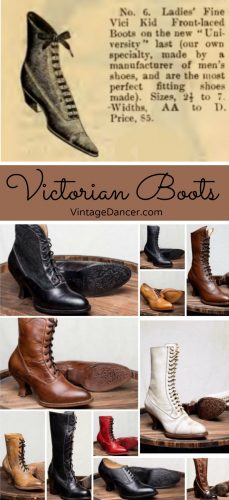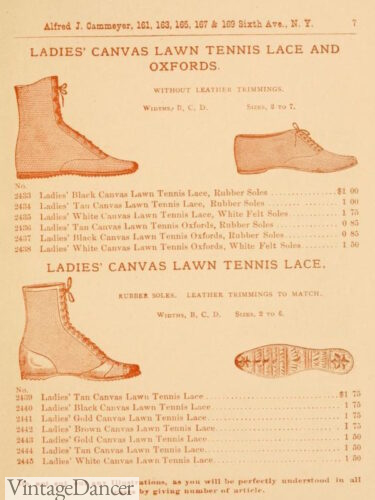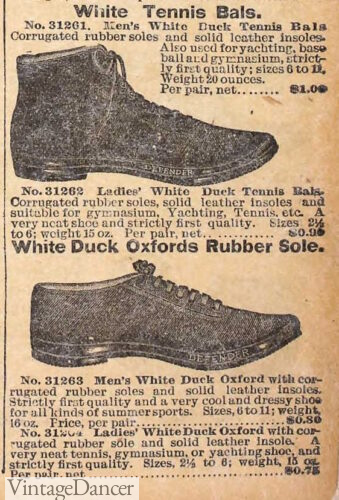Victorian boots and shoes for women were the most common footwear for most of the mid to late 19th century. The tall boot button or lace-up boots provided good ankle support for Victorian women and was the primary shoe. Evening slippers with low heels made for comfortable ballroom dancing shoes while a lace up oxford came in at the end of the century for women who dressed casually.
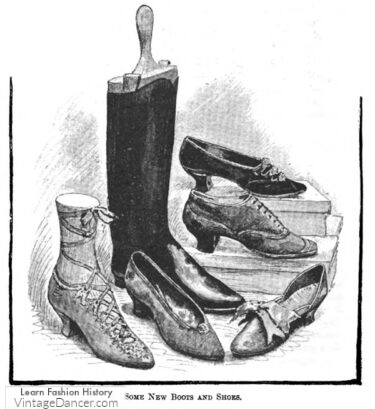
1890s shoes for women
Looking at original vintage women’s boots, I am shocked at how long and skinny their feet were. From the time they were babies, their feet were trained only to fit into dainty boots and shoes (most women were also only 5 feet tall).
Victorian boots came in either black, tan, or two-toned black and white fabric or kid leather. Typically shoes were hand-made by a local shoe cobbler, although in the later years ordering shoes from mail order catalogs was another option.
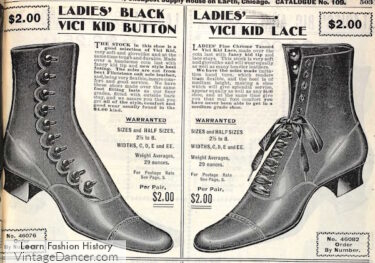
1899 Button boots and Lace Up boots
Boots came in either lace up or button up “spat” or “glove” types which required button hooks to fasten. Some Congress boots were pulled on with elastic insets on one or both sides. Elastic insets were rarer for women’s boots but common for men’s boots.
Continue reading about the evolving history of Victorian era ladies footwear or skip straight to the shopping page.
Victorian Boots and Shoes History
-Victorian Costume and Costume Accessories by Anne Buck, 1961
Victorian Boots
Boots, like the shoes, were in black and white satin for dress wear, and also in white kid. For walking they were usually in cloth, often grey or fawn, with the toe-caps of matching or black leather. They were ankle-length, and laced up the sides on the inside of the foot.
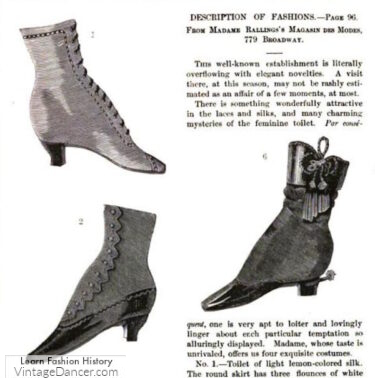
1869 Ladies boots – laces, button, pull on
The elastic-side boot, that is, a boot with an elastic gusset at each side, was patented by the firm of Sparkes Hall in 1837 and continued in fashionable wear until about 1870. They went by the name Congress boots.
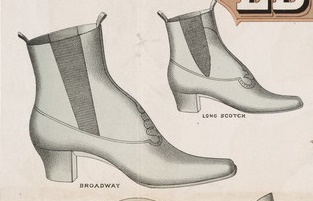
1878 Congress boots (elastic side panel)
Satin boots were very generally worn for dress occasions and many surviving examples were worn as wedding boots. The boots featured earlier than the shoes the distinctive shaping for left and right foot, and they acquired heels a little earlier than the shoes.
In the late 1860s, boots with front lacing and boots which buttoned at the sides appeared. Between 1864 and 1868, there was a fashion of ornamenting the top of the boot with tassels. Boots, like shoes, were often made in brightly colored materials during the 1860s; blue satin was particularly popular.
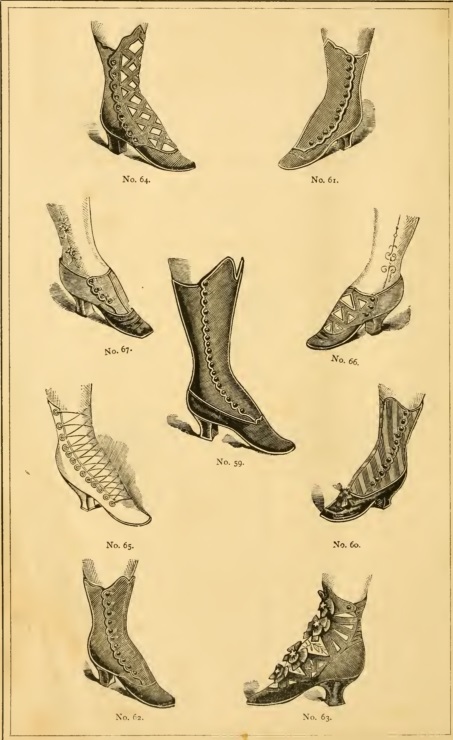
1877 Ladies Boots- fancy buttons and laces
During the 1870s, the heel, on shoes and boots alike, grew a little higher, became more tapering and was set well under the foot. Known as the “Louis” heel from the resemblance to the heels of French shoes of the eighteenth century, this form is found on boots and shoes to the end of the period.
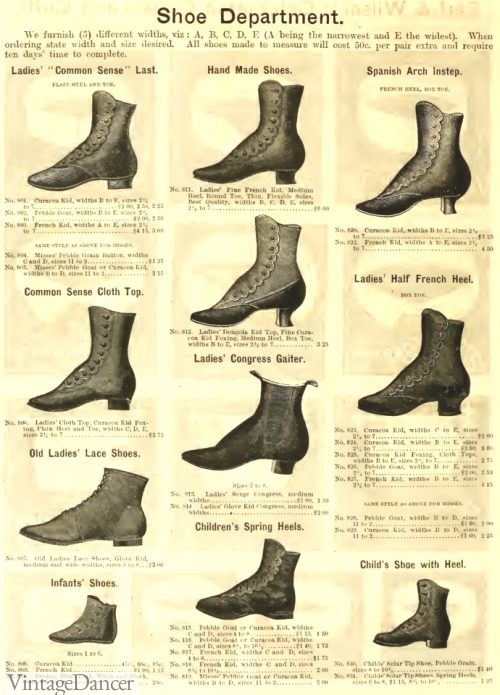
1886 button boots, simple lace boots for women and children
The height of the heel is usually between one and a half to two inches. The square shaping of the toe gradually changed during the 1870s to a more pointed form; by the mid-1880s, the pointed toe was an established fashion, and this style continued, with some lengthening, during the 1890s.
A few dress boots in white satin or velvet were still worn in the 1870s. Some, like the shoes, had bar fastenings, but in the second half of the period, boots were worn mainly for walking or traveling. They were usually in cloth, with a leather galosh, or in leather, laced at the front or buttoned at the side.
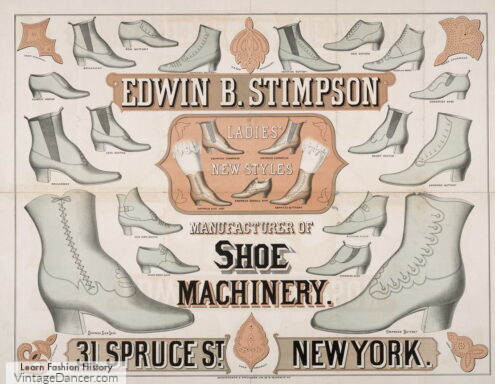
1878 white ladies boots and shoes
During the 1880s and 1890s, they gradually extended higher up the leg, and at the end of the century, they had fastenings of about sixteen buttons or pairs of holes for lacing.
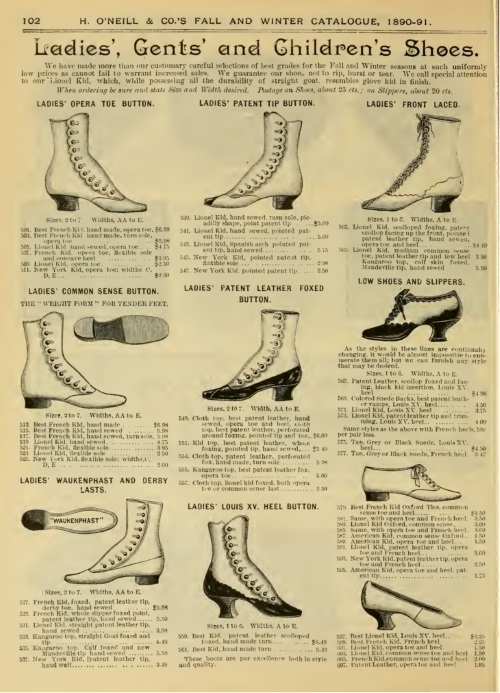
1890 white “spat” button boots
Continue reading about 1900-1920 Edwardian Shoe styles.
Evening Shoes and Slippers
One type of Victorian shoe survives in greater numbers than any other, a slim, heelless shoe in black or white satin, which was the fashionable dress shoe from about 1830 to 1860.
This plain, heelless form, which at first sight seems monotonously the same, did change a little within its period of fashion. The pre-Victorian shoe of the 1820s was rounded at the toe.
By about 1830, the toe was more nearly square and, by 1840, the I shoe had lengthened and narrowed, so that the front was shaped I to an almost perfect rectangle, with the sides of the foot showing the minimum of curve.
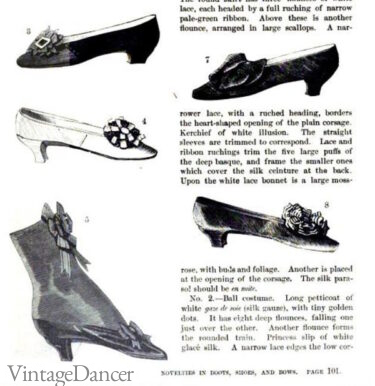
1869 ladies ballgown evening slippers
By 1860, although the foot was still square, it was less sharply so and there was some broadening (of the foot. The shoes of this early period rarely show any difference for left and right foot.
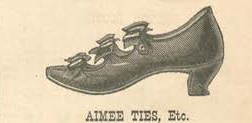
1879 bow tie ribbon shoes
The usual material for evening dress shoes was white satin and, for formal day dress, black satin. Leather was used for ordinary wear and cloth was also used, sometimes in neutral shades of / grey or fawn.
The dominance of black and white was broken by a temporary revival of coloured shoes for evening wear in the late 1840s. There are shoes in figured satin from this time and shoes with embroidered fronts. Slippers were made in Berlin woolwork.
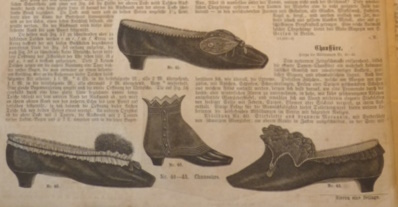
1865 ladies slippers
Change came in the 1850s when heels began to appear: “some- what high-heeled shoes are becoming general, not only for walking, but for the ballroom” {Ladies’ Cabinet, 1850). The height of the heel at this time was an inch or less. The heelless fashion still continued for evening shoes for some years longer, but in the 1860s heels to shoes became general.
A new fashionable attention to shoes and boots completed the change in the 1860s. “A great revolution has taken place in the chaussure of ladies, which generally speaking admits of but little variety. For the black shoe and boot which used to be worn on nearly all occasions, colored ones are substituted, to accord nicely with the dress with which they are worn” (Englishwoman’s Domestic Magazine, 1862).
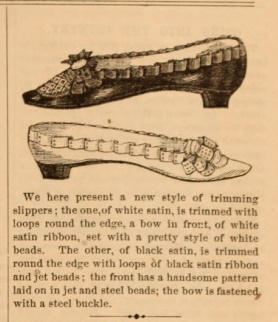
1862 evening slippers trimmed in ribbon
The earlier shoes were very plain, bound round the top with a narrow ribbon, finished at the front with a small, flat bow; often there were long narrow ribbons which crossed over the instep and went around the ankle.
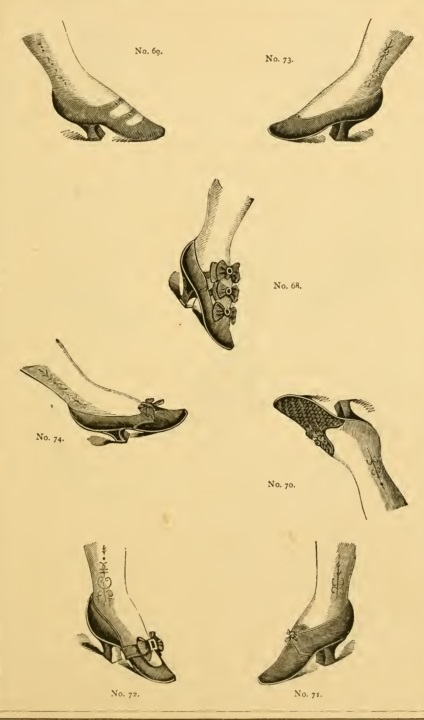
1877 ballroom shoes or slippers
In the 1860s the small bow at the front grew to a large bow or rosette, often with a small steel buckle in the center. Many of the leather shoes of this time had ornamental stitching in contrasting colors and were bound with contrasting ribbon, brown and white on bronze, blue and white, cerise and white on black. A bronze kid was fashionable particularly for indoor shoes from this period to the end of the century.

1869 ladies evening slippers
Large rosettes of ribbon gathered into a buckle ornamented the dress shoes of the 1870s; but during the 1880s the large ribbon ornaments disappeared. Shoes with two or three bars across the instep began to appear in the 1870s, and this style, together with a similar style which had a trellis of bars over the instep, was fashionable during the 1880s and continued during the 1890s.
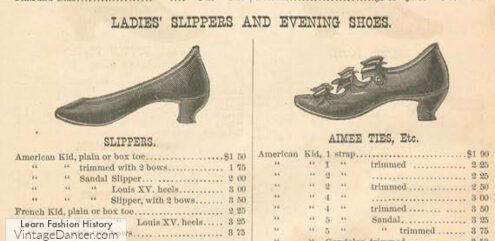
1879 evening shoes – Slippers and three strap bow trim
Bead embroidery ornamented many shoes of this period and cut- out decoration over a contrasting color in kid or satin also appeared on shoes of the 1890s.
But, by 1890, once more the most fashionable shoes of all were plain and untrimmed, except for a small steel or paste buckle at the center front. Evening shoes were of white or colored satin to match the dress.
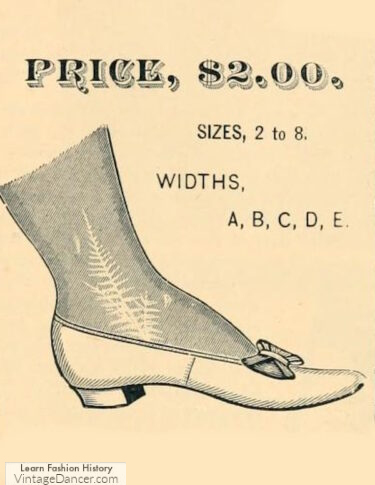
1886 bow slippers
In the late 1890s, a style appeared with a high shaped front above a large square buckle, which bore some resemblance to the eighteenth-century shoe. Unlike their eighteenth-century prototypes, however, the buckles of these shoes were without prongs and were ornamental, not functional.
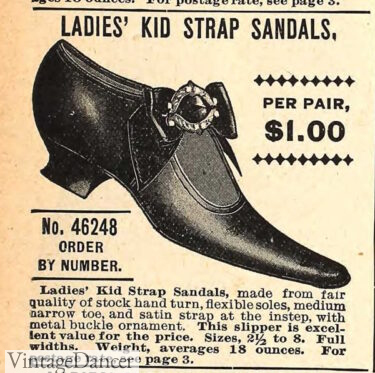
1899 buckle and bow strap shoes
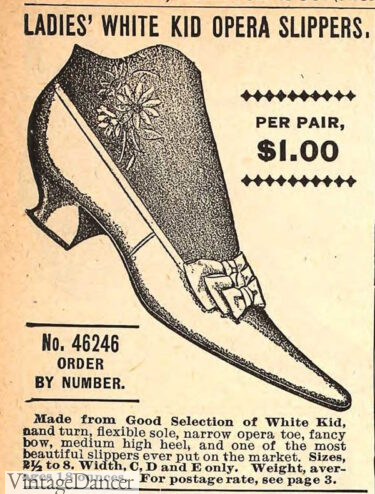
1899 bows on opera slippers
Victorian Sport Shoes
Oxford shoes: A shoe laced over the instep, for walking, appeared in the 1870s and this became the general style for walking shoes during the 1880s and 1890s. The early examples in this style dating from the 1870s and 1880s are usually in soft bronze, black or fawn kid; those of the 1890s are usually black with a toe-cap emphasizing the sharply pointed toe.
Black shoes and boots were worn for outdoor wear in the 1890s, although fawn was accepted for country wear, and white shoes were worn with white summer dresses.
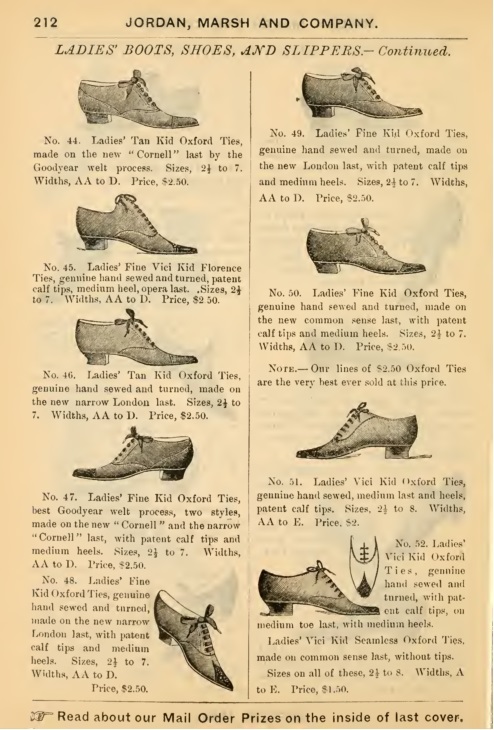
1897 oxford ladies shoes
The popularity of lawn tennis for both women and men created a new oxford style shoes for sportswear. Read more on Bloomsbury
- 1885 ladies lawn tennis shoes
- 1897 white duck cloth tennis shoes
Another sport enjoyed by women was walking or hiking. Learn more about 1900s hiking boots and shoes.
Bicycle riding too was increasingly popular but required taller boots. Victorian bicycle riding outfits.
Reproduction Victorian Boots for Women
Today there is a vast assortment of reproduction Victorian boots for women. Some are cheaper plastic or vinyl “costume” boots, while others are designed for the western Victorian bride and reenactor. Most boots are lace up with two to three-inch heels and pointed toes.
I found that most reproduction Victorian boots only come with a narrow foot and calf to keep with authenticity. My favorite Victorian boots are lace-up boots with zippers on the inside so they are quick and easy to put on. While zippers are not accurate to the era, hardly anyone will notice them under your layers of skirts.
We searched the web for the best Victorian style boots for sale online.
Here are the Victorian boots and shoes.
Debbie Sessions has been teaching fashion history and helping people dress for vintage themed events since 2009. She has turned a hobby into VintageDancer.com with hundreds of well researched articles and hand picked links to vintage inspired clothing online. She aims to make dressing accurately (or not) an affordable option for all. Oh, and she dances too.
